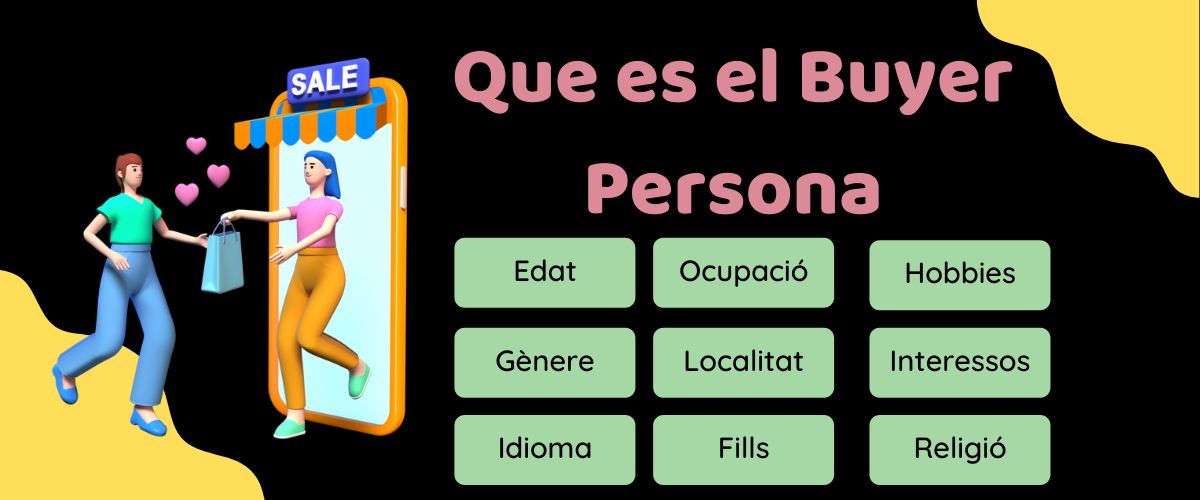Table of Contents
ToggleThe buyer person is one of the most powerful tools for targeting your marketing strategies towards your ideal customers. While the quality content and the seo, this tool helps you establish a more real and personal connection with your audience, increasing the effectiveness of your actions.
Nowadays, many companies devote time, resources and budget to strategies without considering the most fundamental element: knowing the audience they are targeting. In this article, you will learn what a buyer persona is, why it is crucial and how to define it to maximize results.
What is a Buyer Persona?
one buyer person is a semi-fictional representation of your ideal customer based on real data. It is a tool that goes beyond classic segmentation, as it delves into the behaviors, motivations, needs and interests of your target audience. This profile is key to connecting with your customers in a more personal and effective way.
Origins of the Buyer Persona
The concept of buyer persona was introduced by Alan Cooper in 1983 and has since become an essential methodology in modern marketing. Today, it is used by companies and professionals to personalize their strategies and increase the impact of their campaigns.
Differences between Target Audience and Buyer Persona
Many people wonder if the target audience and the buyer persona are the same. Although they are related, they are different concepts:
- Target Audience: It refers to a generic segmentation based on demographic and psychological characteristics.
- Buyer Person: It goes further, creating a detailed profile with a unique identity that allows you to design personalized strategies.
While the target audience can include large groups, the buyer persona focuses on individuals with more specific details that help you connect with them better.

| appearance | Target Audience | Buyer Persona |
|---|---|---|
| Definition | General data-driven segmentation | Detailed profile with real information |
| depth | superficial | Focused on behaviors and motivations |
| approach | large group | specific individual |
| Use | Generic strategies | Personalized communication |
Why is it important to define a Buyer Persona?
Defining a buyer persona is essential to improving the effectiveness of your marketing strategies. Some key benefits are:
- Get to know your potential customers: You will have a clearer view of who they are and what they need.
- Adapt contents and designs: Your messages will be more personalized and relevant.
- Choose the right channels: You will know where your customers are and how to get there.
- Optimize resources: You will reduce expenses by focusing on more effective actions.
- Increase conversions: Well-targeted campaigns are more likely to convert.
How to Define Your Buyer Persona?
Key Steps to Create Your Profile
To build a realistic buyer persona, thorough market research is essential. Here are the essential steps:
Demographic and Professional Data:
- Age, gender, location.
- Occupation and educational level.
Behaviors and Motivations:
- What are your daily needs?
- What problems are you trying to solve?
- What motivates you to make decisions?
Online Behavior and Preferred Channels:
- Which social networks are you most active on?
- How do you communicate and what types of content do you prefer?
Key Questions to Know Your Buyer Persona
Incorporate these questions into your interviews or data analysis to obtain a detailed profile:
- What does your audience do?
- What are your challenges and goals?
- How did they meet you?
- What do they like most about your products or services?
Final Tips for Creating Your Buyer Persona
- Don't Limit Yourself to Demographic Data: Dig deeper into the “why” of your customer's behaviors.
- Check and Adjust Regularly: Your customers evolve, so your buyer persona should too.
- Take advantage of digital tools: Platforms like Google Analytics, social media, and surveys are excellent sources of information.
| advice | Description |
|---|---|
| Use real sources | Collect data from Google Analytics, interviews, and surveys to ensure the profile is accurate. |
| Go deeper into emotions | Ask yourself what motivates or worries your ideal customer to adapt your messages. |
| Update regularly | Customers evolve, so review and adjust your buyer persona periodically. |
Practical Example: Buyer Persona by Laura Gómez
| name | Laura, the manager of a local business |
|---|---|
| age | 35 years |
| Occupation | Owner of a decoration store |
| objectives | Attract more local customers and increase online sales. |
| challenges | Lack of time to manage social networks and optimize the website. |
| Favorite Channels | Instagram, Facebook and newsletters. |
FAQs: Frequently Asked Questions
one target audience is a general segmentation based on demographic and psychographic data, such as age, gender, location, and interests. In contrast, a buyer person is a more detailed semi-fictional representation of the ideal customer, which includes specific information about their behaviors, motivations, needs and challenges. While the target audience offers a broad view of the market, the buyer persona provides a deep and personalized understanding of potential customers, allowing you to better tailor marketing strategies.
Information to develop a buyer persona can be obtained through several sources:
Surveys and interviews: Ask direct questions to current and potential customers to understand their habits, preferences and challenges.
Data analysis: Examine data from Google Analytics, social media and other tools to identify behavioral patterns.
Feedback from the sales and customer service department: Teams that interact directly with customers can provide valuable insights into their needs and concerns.
Depending on the diversity of your offering and your market, it may be beneficial to create multiple buyer personas. For example, if you sell different products or services that cater to different market segments, each segment may require a specific buyer persona to effectively tailor your marketing strategies.
Markets and consumer behavior evolve over time. It is advisable to review and update buyer personas at least once a year or when there are significant changes in the market, consumer trends, or the company's offerings.
5. How can I use the buyer persona in my marketing strategy?
Once defined, buyer personas can be used to:
Personalize content: Create messages and campaigns that resonate with the specific needs and interests of each buyer persona.
Select appropriate communication channels: Identify where each buyer persona is located (social networks, blogs, email, etc.) and direct marketing efforts there.
Develop products or services: Adapt the offer to better meet the expectations and needs of ideal customers.
Trust Daimatics to Improve Your Strategies
A Daimatics, we are experts in digital marketing and we help you create buyer personas to optimize your marketing strategies. Discover how we can help you better connect with your audience and increase conversions.
👉 Check out our digital marketing services at Daimatics.








